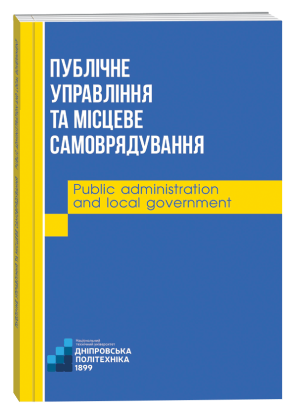MODERN LOCAL GOVERNMENT – A NEW CONTENT OF ACTIVITY WITHIN THE TERRITORY OF THE COMMUNITY
DOI:
https://doi.org/10.33287/101916Keywords:
democratization, decentralization, regional power, local self-government, public officials, local budget, strategic community development, public governance.Abstract
A number of public reforms have been underway in Ukraine for the third year, and administrative reform is of particular importance for a new level of state development, which aims to change the status of local authorities, accountability and content of their social work. Attempts to initiate public authority reform have been made several times, but political will has not been sufficient, the changes have been superficial: signboards replacement and re-subordination. As a rule, such actions did not change the old authoritarian system of government, the system and content of activity in government structures, and accordingly it changed only external factors, which as a result aggravated the situation in the regions, deepened the excessive centralization of territorial governance, violating European principles of self-government and budgeting. Gradually, we came to the state and tendencies that in the process of activity became a burden for state development, removal of local authorities from influencing real situation within the territory and the lack of strategy for its development. Local authorities, as usual, expected financial subventions from the central government to solve particular territorial problems (roads, social facilities, community improvement, etc.), local authorities were discouraged from solving territorial problems and deepened destructive processes (corruption, abuse in the financial sphere, deepening the processes of complication of social status of territories, etc.) It could not last long, substantial and profound changes in territorial management, redistribution of powers, financial resources and spheres of responsibility for the real situation should have been implemented. Responsibility and resources (material, financial) were transferred from the center to the local government level. The powers of the deputy and the chairman of the local community are now filled with specifics and responsibility for solving problems of social development within the territory. Democratization of the processes of public authorities activity from the center to the region outlined legal and practical problems regarding the competence and content of officials: the ability to communicate on certain aspects of community activity; analytical skills and practices; involving citizens in the process of preparing public decisions within the territory; strategies of activity and preparation of community work plans. The vision of the problems of the territory and the strategy of solving them becomes the key to changing the life practices of the community.
References
Бородін Є. І. Генсон про шляхи демократизації та децентралізації публічних інституцій держави / Бородін Є. І., Безена І. М., Марк Е. // Публічне управління та митне адміністрування : наук. зб. – 2019. – № 3(22). – 290 с.
Вільхова Т. В. Застосування маркетингових інструментів у закладах загальної середньої освіти / Т. В. Вільхова, Ю. М. Могила // Економіка та держава. – 2018. – № 5. – С. 57 – 59.
Дегтярьова І. О. Принципи нової регіональної політики України / Дегтярьова І. О. // Теорія і практика державного управління. – 2009. – № 3(26). – С. 3 – 8.
Децентралізація дає можливості. Дніпропетровська область : [сайт]. – Режим доступу : https://decentralization.gov.ua/areas/0562.
Перспективний план формування територій громад Дніпропетровської області : розпорядження Кабінету Міністрів України від 5 серп. 2015 р. № 846. – Режим доступу : https://zakon.rada.gov.ua/laws/show/846-2015-р.
Романенко К. М. Маркетинг у державному управлінні : монографія / К. М. Романенко. – Дніпропетровськ : ДРІДУ НАДУ, 2012. – 392 с.
Хабермас Ю. Постнациональная констелляция и будущее демократии / Ю. Хабермас ; пер. Б. М. Скуратова // Логос. – 2003. – № 4 – 5(39). – С. 105 – 152.






